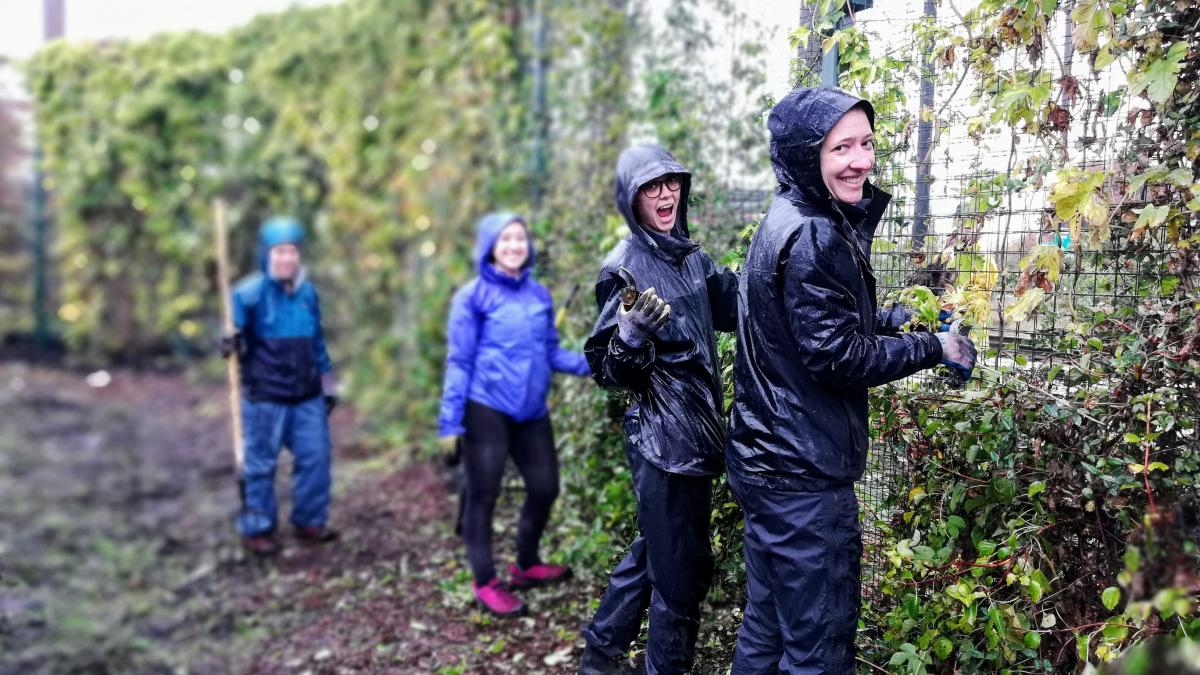
The UW SRP community engagement core organized volunteers to help maintain a Green Wall in Seattle's Georgetown neighborhood.
On October 19, Superfund Research Center trainee Megumi Matsushita worked in the rain to pull weeds and spread mulch at the Georgetown Green Wall in South Seattle's Duwamish Valley.
Matsushita usually spends her days working in the lab of Dr. Zhengui Xia, studying how exposure to cadmium affects memory and brain function. But on this rainy Saturday, she put her muscles to work in a narrow strip of land between a railroad track and CDL Recycle – an industrial recycler that Georgetown neighbors say has sent choking plumes of dust into their neighborhood for years. Those neighbors are now working with the company on a solution – a 126-foot long, 13-foot high Green Wall designed to capture dust and other particulates in the air in this historically industrial neighborhood. "I'm working hard to contribute to the scientific community through my research," said Matsushita of her experience. "But I also want to make an honest effort to build a relationship with and work with the communities affected by the Duwamish River Superfund site."
Studies have shown that Green Walls like this, when properly designed and maintained, can reduce airborne particulates by up to sixty-percent. That's a reduction Georgetown welcomes. The neighborhood sits within the 98108 zip code which has disproportionately high diesel particulate concentrations in their air, and the city's highest rates of childhood asthma hospitalizations – just two of the indicators of poor health that have been documented for people living in the Duwamish Valley. This Green Wall is one part of the community's self-directed response. "The neighborhood wanted to take action," say Georgetown resident Andrew Shifter. "They also wanted a big, beautiful project that would that would showcase the neighborhood, and help convince the City that Georgetown was worth investing in."
Originally built by the Duwamish River Cleanup Coalition and Just Health Action in 2016 with funding from EPA and King County, the Georgetown Green Wall has become a living air scrubber in an area with very little green space and lots of sources of pollution – in the air, in the river, and in neighborhood soils. Megumi and staff from the UW SRP worked alongside neighborhood volunteers under the guidance of Shifter, who is also the director of DIRT Corps – a green infrastructure training organization. Together, they spent the day helping twine the pollution-absorbing vines comprising the Green Wall into the wall's fenced lattice, coaxing them to grow ever higher. After four years, many of the vines now approach the top of the wall's free-standing structure, the largest Green Wall in the city.
Georgetown's Green Wall has been an inspiration to many. Across the river, South Park neighbors built a smaller "Green Screen" outside of the local library, which borders Highway 509 and its heavy traffic, and are now building a new Green Wall next to the neighborhood skate park, frequented by many of the valley's youth. Members of the Duwamish Valley Youth Corps are also working with scientists to monitor sources of air pollution using moss collected from local trees. Once the results are in, more Green Walls may be part of the solution to pollution in new areas where high levels of chemical pollution are found. In the meantime, the SRP program plans to organize volunteers from the Department of Environmental and Occupational Health Sciences to help out at the Georgetown Green Wall twice a year – join us for the next opportunity on Earth Day 2020!

